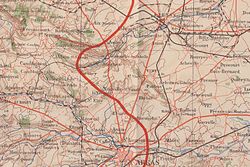
Back Другая бітва пры Артуа Byelorussian Druhá bitva u Artois Czech Lorettoschlacht German Bataille de l'Artois (mai-juin 1915) French קרב ארטואה השני HE Második artois-i csata Hungarian Pertempuran Artois Kedua ID Seconda battaglia dell'Artois Italian Вторая битва при Артуа Russian Lorettoslaget Swedish
| Second Battle of Artois | |||||||||
|---|---|---|---|---|---|---|---|---|---|
| Part of The Western Front of the First World War | |||||||||
 Western Front, Artois: Arras sector, January 1915 | |||||||||
| |||||||||
| Belligerents | |||||||||
|
| |||||||||
| Commanders and leaders | |||||||||
|
Joseph Joffre Victor d'Urbal Douglas Haig | Crown Prince Rupprecht of Bavaria | ||||||||
| Strength | |||||||||
|
9 French and British divisions (initial) 20 divisions (final) | 18 divisions (final) | ||||||||
| Casualties and losses | |||||||||
|
French: 102,500 British: 27,809 (Aubers Ridge: 11,161, Festubert: 16,648) | Germany: 73,072 | ||||||||
Artois, a region of northern France including the cities of Arras, Saint-Omer, Lens and Béthune. | |||||||||
The Second Battle of Artois (French: Deuxième bataille de l'Artois, German: Lorettoschlacht) from 9 May to 18 June 1915, took place on the Western Front during the First World War.[a] A German-held salient from Reims to Amiens had been formed in 1914 which menaced communications between Paris and the unoccupied parts of northern France. A reciprocal French advance eastwards in Artois could cut the rail lines supplying the German armies between Arras and Reims. French operations in Artois, Champagne and Alsace from November–December 1914, led General Joseph Joffre, Generalissimo (Commander in Chief) and head of Grand Quartier Général (GQG), to continue the offensive in Champagne against the German southern rail supply route and to plan an offensive in Artois against the lines from Germany supplying the German armies in the north.
Field Marshal Sir John French, commander of the British Expeditionary Force (BEF), co-operated with the French strategy to capture Vimy Ridge by planning British attacks against Aubers Ridge. The attacks would confront the German 6th Army with a joint offensive, on a 70 mi (110 km) front, eastwards into the Douai plain, where an advance of 10–15 mi (16–24 km) would cut the railways supplying the German armies as far south as Reims. The French attacked Vimy Ridge and the British attacked further north in the Battle of Aubers Ridge (9 May) and the Battle of Festubert (15–25 May).
The battle was fought during the German offensive of the Second Battle of Ypres (21 April – 25 May), which the Germans ended to reinforce the Artois front. The initial French attack broke through and captured Vimy Ridge, to the surprise of both sides. German counter-attacks forced them back about half-way to their jumping-off points before French reserves could reach the battlefield. The British attack at Aubers Ridge was a costly failure and two German divisions in reserve were diverted south against the Tenth Army. The British offensive was suspended until 15 May, when the Battle of Festubert began and French attacks from 15 May to 15 June were concentrated on the flanks to create jumping-off points for a second general offensive, which began on 16 June.
The British attacks at Festubert forced the Germans back 1.9 mi (3 km) and diverted reserves from the French but the Tenth Army gained little more ground, despite firing double the amount of artillery ammunition and many more casualties on both sides. On 18 June, the main offensive was stopped and local French attacks were ended on 25 June. The French had regained 6.2 sq mi (16 km2) of territory but their failure to capture Vimy Ridge, despite the expenditure of 2,155,862 shells and the suffering of 102,500 casualties, led to recriminations against Joffre. The defence of the ridge cost the German 6th Army 73,072 casualties. A lull in the area followed until the Third Battle of Artois in September.
- ^ Edmonds & Wynne 1995, p. 68.
Cite error: There are <ref group=lower-alpha> tags or {{efn}} templates on this page, but the references will not show without a {{reflist|group=lower-alpha}} template or {{notelist}} template (see the help page).
© MMXXIII Rich X Search. We shall prevail. All rights reserved. Rich X Search
